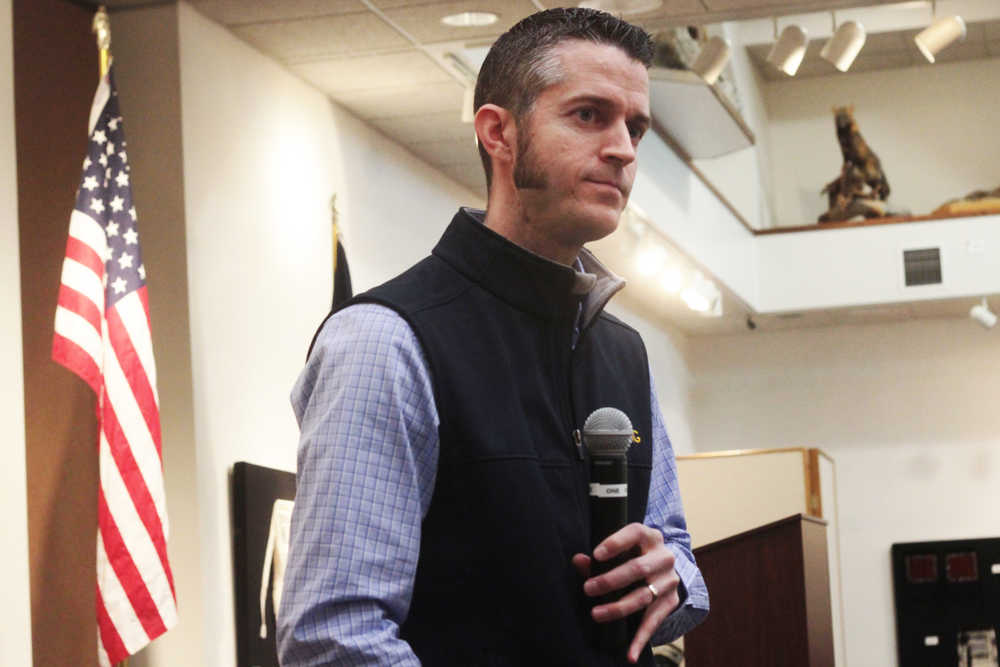KENAI — Kenai Peninsula representatives of the Alaska Liquefied Natural Gas (LNG) Project said that although their leaders have spoken of possible delays, employees of the project remain set on smaller steps before them.
These steps include creating final drafts of impact reports and completing property acquisitions for the prospective pipeline’s liquefaction facility and export terminal in Nikiski.
On Wednesday, representatives of the Alaska LNG Project partners — the state of Alaska, BP, Exxon Mobile, and Conoco Phillips — said at an Anchorage press conference that uncertainty over the global LNG market may bring changes to the larger structure of the project. In a public meeting Saturday at the Kenai Visitor Center, Alaska LNG Community Stakeholder Advisor Josselyn O’Connor said these possible changes were not prompting hesitation with the project’s work.
“Our marching orders are to get through and complete pre-FEED,” O’Connor said, using the project’s acronym for pre-Front End Engineering and Design — the preparatory work needed to decide whether to invest in building the 806-mile pipeline to carry natural gas from the North Slope.
Since 2012 the Alaska LNG partners have invested approximately $500 million in conceptualizing the pipeline, including $230 million budgeted for 2016, and are expected to make a further investment of up to $2 million if they continue to actual engineering and design. The Alaska LNG project has estimated it will ultimately spend between $45 and $60 billion on its facilities.
“We know there’s a lot of noise around the project right now,” O’Connor said. “But we’re committed to pre-FEED. I think the owners stood up and said they’re committed to pre-FEED. We’re also looking at optimization: how do we get the cost of this project closer to the lower end of that price ticket? The other big thing is the resource reports. Those have to line up.”
Alaska LNG will have to submit 13 reports of the project’s estimated effect on the local environment and culture the Federal Energy Regulatory Commission, a national licensing authority.
O’Connor said she expects the reports to be submitted in summer 2016.
In response to an audience question, O’Conner said Alaska LNG will not need to complete its land purchases for the Nikiski facility in order to continue FERC licensing. She said the project has purchased about 570 acres and will eventually need to buy between 800 and 1,000 acres for the Nikiski terminal.
Larry Persily, a former federal oil and gas coordinator and current advisor to Kenai Peninsula Borough Mayor Mike Navarre on LNG issues, said FERC would consider Alaska LNG’s application even if its acquired land is “a little bit of a jigsaw, and there’s a few pieces missing.”
“When the project applies to the Federal Energy Regulatory Commission, they have to show they control the site,” Persily said. “The law does not require that they own 100 percent of the property, but they’ve got to show federal regulators that they have enough of the property under contract purchase option to show they control it.”
He added that at least one prospective LNG project has been denied a FERC license for lacking sufficient control of property.
When asked by an audience member what the project might do with the land if it does not reach the building stage, Alaska LNG Project Advisor Jeff Raun was uncertain.
“In terms of our property management plan, I’m not sure of a clause that says ‘what do we do if…?” Raun said.
In an interview afterward, Persily said that in the event the Alaska LNG Project decides not to build, recouping the land investment would be “the least of their worries,” and the property tax the project would continue to pay on the unused land would be a small part of its overall expenses.
At the meeting’s conclusion, Persily also commented on the presently oversupplied global LNG market, in which major buyers in South Korea and Japan have dropped their imports by around 14 percent over the past two years, according to an email update by Persily.
“The only LNG export projects anywhere in the world in the past few years that have gone to a final investment decision — because the market is so bad — have been the ones on the U.S Gulf Coast, where they already had an LNG import terminal in place,” Persilly said Saturday.
In that case, he said exporting had been viable because it only required a slight reconfiguration of an unused export terminal.
The U.S largely stopped importing natural gas after the technique of extracting gas from shale was perfected in the 2000’s, creating a new domestic supply. He added that the only other recent new LNG exporter is an effort subsidized by the Russian government.
In a later interview, Persily said that given the value of the North Slope gas Alaska LNG wants to market, it’s unlikely Alaska’s pipeline and terminal will never be built.
“I don’t think it’s a question of not building it, but when,” Persilly said.
• Ben Boettger is a reporter for the Peninsula Clarion. He can be reached at ben.boettger@peninsulaclarion.com.

